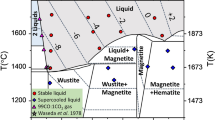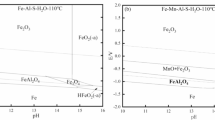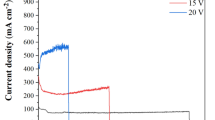Abstract
In connexion with the well-known intercrystalline failure of mild steel in concentrated solutions of sodium hydroxide, it would appear that a study of the anodic behaviour of iron in such solutions might lead to results of considerable interest. A search of the literature soon reveals, however, that but little attention has been devoted to this matter. The work of Grube and Gmelin1, who carried out a careful and extensive investigation in this field, is therefore of special importance. These workers obtained evidence that anodic dissolution takes place in two distinct potential stages: at low current densities electrolysis proceeds at a potential of about — 0·85. V. (hydrogen), whereas at higher values it changes suddenly to + 0·65 V., when oxygen evolution commences. The critical current density was found to increase rapidly with temperature. Evidence is adduced by Grube and Gmelin that the lower (more negative) potential stage is associated with the formation of ferrous ion, and the higher with oxidation to the hexavalent ion Fe6.; anionic complexes being formed having the probable compositions (FeO2)″ and (FeO4)″ respectively.
This is a preview of subscription content, access via your institution
Access options
Subscribe to this journal
Receive 51 print issues and online access
$199.00 per year
only $3.90 per issue
Buy this article
- Purchase on SpringerLink
- Instant access to full article PDF
Prices may be subject to local taxes which are calculated during checkout
Similar content being viewed by others
References
Grube and Gmelin, Z. Elektrochem., 26, 459 (1920).
Cf. Carius, "Korrosion metallischer Werkstoffe" (ed. Bauer-Kröhnke-Masing, Leipzig, 1936), 1, 135.
Author information
Authors and Affiliations
Rights and permissions
About this article
Cite this article
WEIR, C. Anodic Behaviour of Mild Steel Strongly Alkaline Solutions. Nature 160, 259 (1947). https://doi.org/10.1038/160259a0
Issue date:
DOI: https://doi.org/10.1038/160259a0



